Related Research Articles
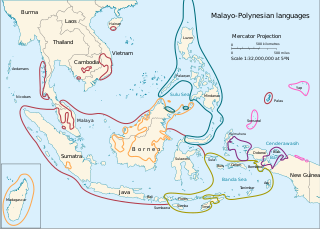
The Malayo-Polynesian languages are a subgroup of the Austronesian languages, with approximately 385.5 million speakers. The Malayo-Polynesian languages are spoken by the Austronesian peoples outside of Taiwan, in the island nations of Southeast Asia and the Pacific Ocean, with a smaller number in continental Asia in the areas near the Malay Peninsula, with Cambodia, Vietnam and the Chinese island Hainan as the northwest geographic outlier. Malagasy, spoken in the island of Madagascar off the eastern coast of Africa in the Indian Ocean, is the furthest western outlier.

Makassarese, sometimes called Makasar, Makassar, or Macassar, is a language of the Makassarese people, spoken in South Sulawesi province of Indonesia. It is a member of the South Sulawesi group of the Austronesian language family, and thus closely related to, among others, Buginese.

The Malayic languages are a branch of the Malayo-Polynesian subgroup of the Austronesian language family. The most prominent member is Malay, which is the national language of Brunei, Singapore and Malaysia, and is the basis for Indonesian, the national language of Indonesia. The Malayic branch also includes the local languages spoken by Indonesians and ethnic Malays, further several languages spoken by various other ethnic groups of Sumatra, Indonesia and Borneo. The most probable candidate for the urheimat of the Malayic languages is western Borneo.
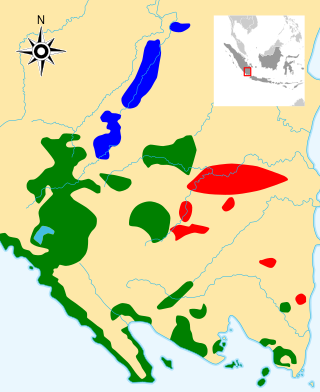
Lampung or Lampungic is an Austronesian language or dialect cluster with around 1.5 million native speakers, who primarily belong to the Lampung ethnic group of southern Sumatra, Indonesia. It is divided into two or three varieties: Lampung Api, Lampung Nyo, and Komering. The latter is sometimes included in Lampung Api, sometimes treated as an entirely separate language. Komering people see themselves as ethnically separate from, but related to, Lampung people.
Proto-Austronesian is a proto-language. It is the reconstructed ancestor of the Austronesian languages, one of the world's major language families. Proto-Austronesian is assumed to have begun to diversify c. 3,500–4,000 BCE on Taiwan.
The Ibanic languages are a branch of the Malayic languages indigenous to western Borneo. They are spoken by the Ibans and related groups in East Malaysia and the Indonesian province of West Kalimantan. Other Dayak languages, called Land Dayak, which are not Ibanic, are found in the northwest corner of Kalimantan, between Ibanic and non-Ibanic Malayic languages such as Kendayan and the Malay dialects of Sarawak and Pontianak.
The Sigulai language is an Austronesian language spoken on Simeulue island off the western coast of Sumatra in Indonesia. It belongs to the Malayo-Polynesian branch of the Austronesian languages. Sikule is one of Northwest Sumatra–Barrier Islands languages, which are a sub-group of Western Malayo-Polynesian.
The Kayanic or Kayan–Murik languages are a group of Austronesian languages spoken in Borneo by the Kayan, Morek Baram, Bahau, and related peoples.
The Land Dayak languages are a group of dozen or so languages spoken by the Bidayuh Land Dayaks of Borneo.
The Barito languages are around twenty Austronesian languages of Indonesia (Borneo), plus Malagasy, the national language of Madagascar. They are named after the Barito River located in South Kalimantan, Indonesia.
The Greater North Borneo languages are a proposed subgroup of the Austronesian language family. The subgroup covers languages that are spoken throughout much of Borneo, as well as parts of Sumatra and Java, and Mainland Southeast Asia. The Greater North Borneo hypothesis was first proposed by Robert Blust (2010) and further elaborated by Alexander Smith. The evidence presented for this proposal are solely lexical.
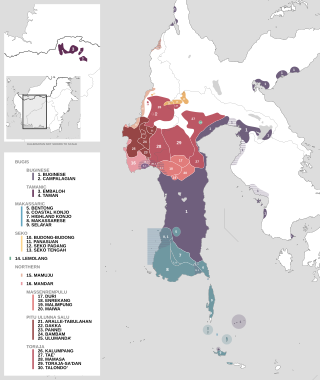
The South Sulawesi languages are a subgroup of the Austronesian language family. They are primarily spoken in the Indonesian provinces of South Sulawesi and West Sulawesi, with a small outlying pocket in West Kalimantan.
The Celebic languages are a subgroup of the Austronesian languages spoken on the Indonesian island of Sulawesi, formerly called Celebes. Almost all of the languages spoken in the provinces of Central Sulawesi and Southeast Sulawesi belong to the Celebic group. A few Celebic languages are located in South Sulawesi province. By number of languages, Celebic is the largest subgroup of Austronesian languages on Sulawesi.
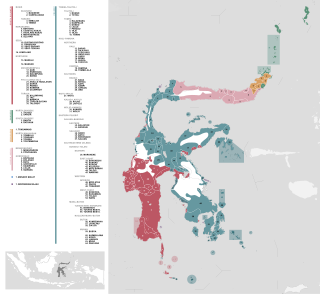
On the Indonesian island of Sulawesi, 114 native languages are spoken, all of which belong to the Malayo-Polynesian subgroup of the Austronesian language family. With a total number of 17,200,000 inhabitants, Sulawesi displays a high linguistic diversity when compared with the most densely populated Indonesian island Java, which hosts 4–8 languages spoken by 145,100,000 inhabitants.
Kei is an Austronesian language spoken in a small region of the Moluccas, a province of Indonesia.
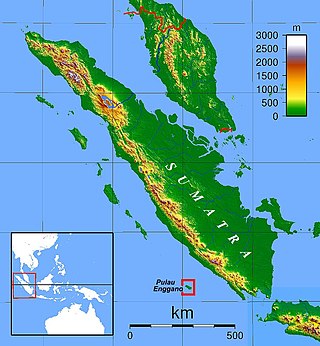
The Enggano language, or Engganese, is an Austronesian language spoken on Enggano Island off the southwestern coast of Sumatra, Indonesia.
Embaloh (Maloh) is an Austronesian (Dayak) language of spoken in West Kalimantan, Indonesia. Apart from Taman, it is not close to other languages on Borneo, but rather belongs to the South Sulawesi languages closest to Buginese. Many speakers of Embaloh also speak Iban, leading to the adoption of some Iban loanwords into Embaloh.
Matbat is a heavily Papuan-influenced Austronesian language spoken in West Papua, Indonesia, on the island of Misool, Raja Ampat islands. Its dialects are Magey and Tomolol. Similar to the neighboring Ma'ya language, Matbat is one of a handful of Austronesian languages with true lexical tone rather than a pitch-accent system or complete lack of phonemic tonal contrasts as with most other Austronesian languages.
Ot Danum is a Barito language of the central Borneo, Indonesia, spoken by the Ot Danum people. Dialects include Cihie and Dohoi.
References
- 1 2 K. A. Adelaar. 1994. The classification of the Tamanic languages. In Tom Dutton and Darrell T. Tryon (eds.), Language contact and change in the Austronesian world, 1-42. Berlin: Mouton de Gruyter.
- ↑ K. Alexander Adelaar and Nikolaus Himmelmann. 2005. The Austronesian languages of Asia and Madagascar. London: Routledge.
- ↑ Smith, Alexander D. (2017). "The Western Malayo-Polynesian Problem". Oceanic Linguistics. 56 (2): 435–490. doi:10.1353/ol.2017.0021. S2CID 149377092.
- ↑ Bamba, John (ed.) (2008). Mozaik Dayak keberagaman subsuku dan bahasa Dayak di Kalimantan Barat. Pontianak: Institut Dayakologi. ISBN 978-979-97788-5-7.
- ↑ Istiyani, Chatarina Pancer (2008). Memahami peta keberagaman subsuku dan bahasa Dayak di Kalimantan Barat. Institut Dayakologi.